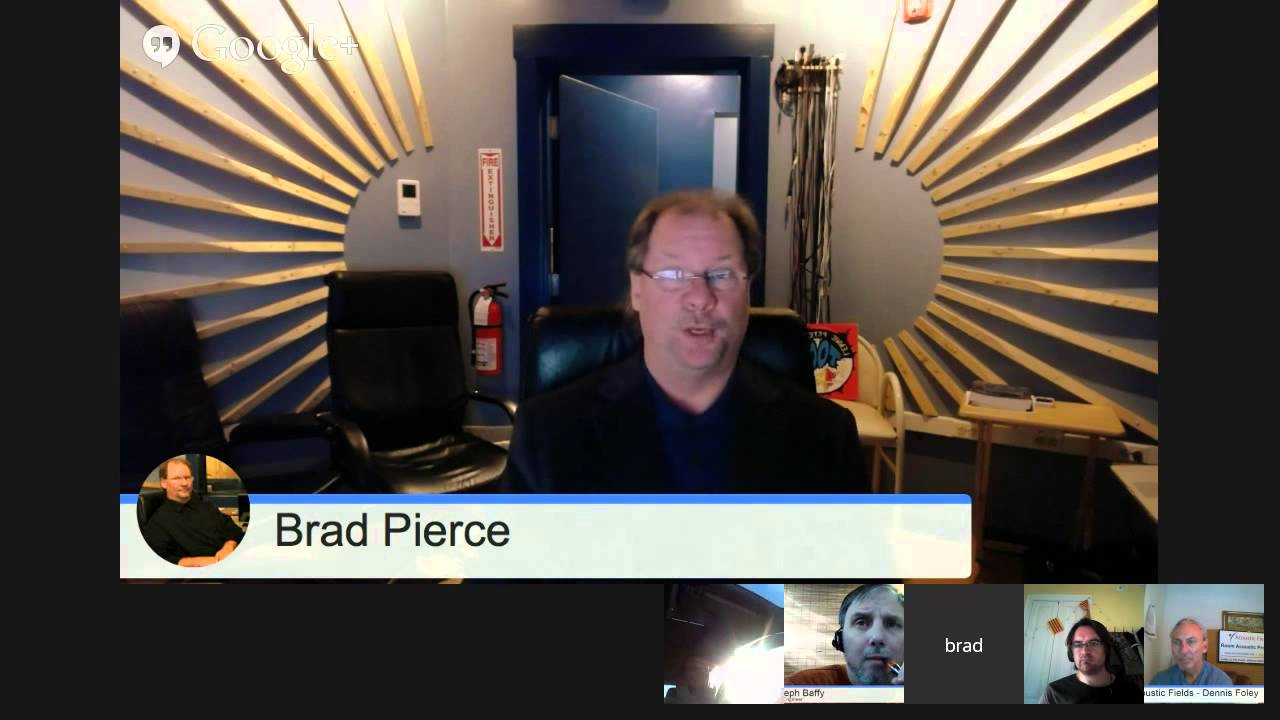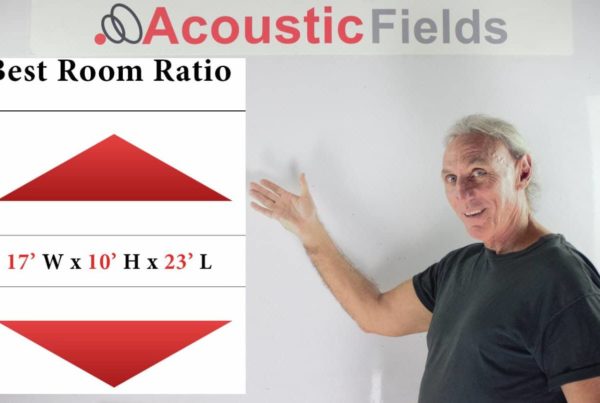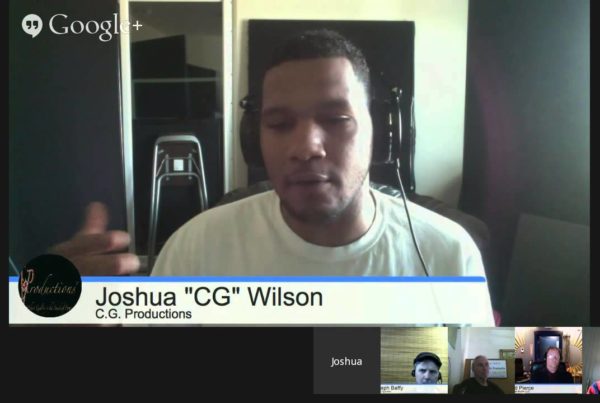In another of our monthly Google Hangouts with experienced and talented audio engineers Brad Pierce, Joseph Baffy and Joshua Wilson, we continued in our efforts to bridge the gap between what you are hearing as an engineer and how the room is causing that problem. The following video and transcript comes from one particular section where we addressed the issue “How to record drums in different environments”. If you would like to see the full hour and a half discussion you can see the video further down the page.
Dennis: Brad, tell us a little bit about some of your experiences. I am very interested in that example in the church.
Brad: Yeah, well, there was probably a 40 foot ceiling, maybe a 60 foot ceiling something like that. The pair that I had in front behind the conductor, I had up pretty far I guess, you know we always do maybe a little experimentation in different rooms. Location recording doesn’t always give you the chance to do much experimentation except concert to concert. But when the fan speed was high, that air pressure was just being blown down on top of the microphones and you didn’t hear it all the time but you definitely heard it when the air movement, the pressure would build from the other fans.
Snd you would get diaphragm distortion where it sounded like the diaphragm and the mic was just pushed almost like a DC offset. You could see it in the wave form but you didn’t really get an audible effect when you listened to it. Except maybe some grumbling or very low frequency information. It’s just the proximity of the fans in relationship to the proximity of the orchestra or the source that I was recording was a bit off. So, what I had to do in the future was first, ask them to turn fans off which they weren’t too happy about in July or move the microphones closer to the source which I do now just because of that unless it’s winter when I have free reign of the room. So that’s basically how it turned out from there.
Dennis: Can you just describe a little bit about the difference in sound between that recorded sound in that bigger room and a smaller room? Can you give us just a couple differences that jump right out at you?
Brad: Sure, it’s mostly a choir small orchestra type situation of that location recording. I’ve recorded them also in smaller churches. One in particular was very dry, I was surprised how dry the room was in this particular church because you have a lot of people and if they have coats on but the inside of the church had a lot of drapery and fabric materials, carpeted flooring as opposed to the other place which is basically a huge shoe box made out of marble which is pretty much, the decay time is really pretty long. It’s got to be close to 6 seconds or so. In the dry room, I would be able to move the microphone to a little bit further back because I don’t have the effect of the room destroying the source sound or mixing in with the source sound in such a great ratio that it sounds like you’re in a gymnasium.
So when you have a dry room and more managed decay times, you are able to put the microphone a little further back from the source which lets the voices blend a lot better, the strings blend a lot better. The whole presentation of the recording is definitely a lot better as opposed to having the big gymnasium type sounding room. So, when you have a dry room of course the voices, the people singing, they like to sing more in a reverberant room because it helps singers, it makes them feel more comfortable than singing in just a dry room.
But in production, you obviously, you have the option to introduce artificial reverberation. So you can control the sound a lot more and relating this back to a drum room, if you have a smaller room, I probably would have to design the room to be a little more absorbent as far as containing the early reflections and that allows you in production and mixing afterwards to tailor the room sound a little more artificially. I mean if that’s what you have to work with then you need to deal with it in the best possible way.
So controlling early reflections would be important. Absorption in a balanced way so that you are not absorbing a lot of high frequencies and you have a lot of low frequencies with longer decay times so you really do need to manage the absorption across the frequency spectrum to be balanced and you’ll get the best sounds. And obviously telling Dennis about your dimensions and talking to him about what your room needs, he would be able to help you manage and get that balance of decay times.
Dennis: Let’s talk a little bit about the sonic qualities of the recording: large room versus small room. Let’s focus on definition. What’s the difference in definition in the low end between a small and a larger room on a recorded signal?
Brad: I would think that from my experience in a dryer smaller room such as that church say, the definition of the sound is so much better because you are not getting a lot of decay time wash out. So all of the attacks of the instruments are being washed out and less defined because they are mixing in with all of the decay time of the room which gives you kind of a washing machine, you know potpourri of attacks of all the instruments and it just gets washed all together like a washing machine. Dryer rooms definitely have more definition I would think of the attack times of the instruments.
Dennis: Would you say as an engineer you use less electronic manipulation in a larger room recording of drums than you would in a smaller room recording of drums?
Brad: Yes, I think in a larger room with a drum instrument or drum kit, you are able to get the microphones further from the source. So you’re letting the instrument breathe a bit in the room and the blend of the drum kit of all the cymbals, toms, snare and kick drum, you’re letting that kind of blend together in the room before you’re capturing it. It’s like the difference of doing a close-mic set up on individual drums and using no overheads to using overheads, kick and a snare mic.
So you’re using basically that kick and snare mic to provide the definition of the attack and you’re using the overheads to capture the blend of the instrument. So whenever you close mic something you know you are zooming in microscopically on the instrument sound and typically we don’t put ourselves that close to listen to a drum kit. So you get more of a natural sound in a bigger room because you can move the mics away and balance the blend of the instrument to the room.
Dennis: So is it safe to say if we have control of the pressure, more control of the pressure of the room and more control of the reflections in the room we have a better chance of a better quality recording?
Brad: Yeah, I would so, that the room modes are gonna be a big issue in a smaller room. So you are gonna want to reach for your EQ which is not going to do too much. In a smaller room, you’re going to have to experiment. Move the microphones around because you’re going to find the nodes and anti-nodes of the standing waves and you’re going to notice a big difference with a small microphone movement in a smaller room.
So with a bigger room, it just breathes better. You’re not going to find such drastic changes in the sound by such small microphone movements because you’re not dealing with the pressure issues and the reflection issues. So you’re going to work a lot less in a bigger room and of course you want a drummer that is talented and you want a drum kit that sounds good. You obviously have to start there and then move to the room, the room size. A crappy, a drum sound, or a crappy set of drums are not going to sound the greatest in a large room. But if you have a good drum set, a good drum set sound tuned correctly, a larger room will really make it shine.
Dennis: Joseph, anything you want to add to that?
Joseph: I think that what you just said, Brad about the you’re not going to work as hard in a large room is a 100% correct. I found the exact same thing. In a larger room, I spent more time positioning gobos to stop the tails. I’m talking large rooms, I recorded a young group from our local school in their lunch room and it has one of those cork type ceilings you know, it’s like your standard cardboard ceiling. But it’s a good 20 ft up and everything else is either tile or concrete. I think I spent 10 minutes putting the mics up and half an hour getting the gobos behind the mics to stop the crap from interfering to making that washer machine type sound, you know right.
Brad: So you could say that even if you have a big room if it’s not treated properly and it’s out of balance as far as the decay times that could be just as bad as a small room.
Joseph: I think that if you don’t have gobos, I think its worse.
Brad: Yeah, well then you can’t think edit in that case.
Joseph: Yes, you have nothing to get rid of the reflections. Alright cause that’s what we are talking about here. It’s just the reflection is not a micro second away in a 16 ft room, it’s you know, 2 seconds away its worse, you know. It’s actually harder to deal with, and it gets mixed in more to the point where you can’t electronically or digitally manipulate that out so easy.
Brad: Right! You have to use closer mic techniques as well in that situation just to try and manage you know you can use you know, patterns on your microphones that are closed down you know, hyper cardiod you know you would’t use an omni mic. I mean if you had a nice big room where the decay times were nice and even across the frequency spectrum, you know putting up a couple of omni room mics, spaced pair or something like that, I mean that can just make magic happen on your drum kit. It’s almost like a drum kit in a room, in a good room is really want we want to hear. That’s what we like to hear, you know. That’s what we are used to hearing, if you’re lucky enough to hear that type of thing. I mean obviously a lot of the recordings that are done by a lot of the commercial stuff you know they have that great room sound and they have a great drummer and a great drum set and the magic definitely happens when you can have that.
Joseph: Yeah I think that John Bonham. You know, and that’s when I say, that’s when I came up with this contemplating my navel, that you are hearing the room that happens to have musicians in it. You’re hearing the stair wall that has a drum kit in it and a decent microphone I think it was 14, you know that figure 8 styles. There’s really not, I don’t think there’s, you know and this has to be the last time I’m going to say this, there’s not a way to not hear a room in a recording unless, there just isn’t unless what, unless you have one of those boxes that you put your amplifier in and you call that a room, you know what I mean? One of those iso boxes.
There is just isn’t a way, it’s just a bunch of different compromises that you make a long the way to try to achieve a good recording. And Dennis you know that’s the quickest way to put it. You know pressure, reflections. How’d you say it before waves and rays. And for drums for me, its pressure. You know there’s ways around you know a lot of the reverb times and you know and even the pressure. To me, it’s the pressure man. You know, it’s just too much for a small room.
In Summary
To learn more about room acoustics and how drums interact with your room, please sign up to download our free ebooks and video series on room acoustics here. And please let me know if you have any questions at any time.
Thanks
Dennis Foley







